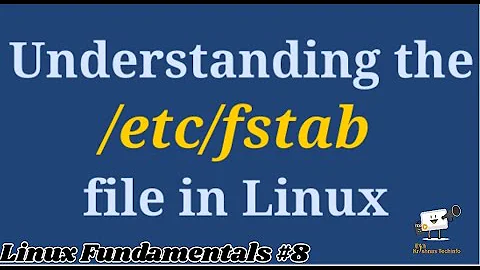What is the difference between a symlink and binding with fstab?
bind mirrors a filesystem (among other situatons, it's useful when setting a chroot inside which you need to have a "complete" system (like when unpacking/installing Gentoo).
Just simply like that, it mirrors a tree from A into B. I don't know for sure if it has any option, but I doubt it, it does not do more than, well, mirroring.
Unlike a symlink, which is a file in a filesystem pointing to another filesystem, requiring you to set it up, and is still a "special file", bind really mirrors the whole subtree. Depending on the tool, both strategies may work, but it is possible to detect the symlink and some tools may resolve it to the original path. The bind approach is more transparent, acting like two different filesystems.
Related videos on Youtube
cwd
Updated on September 18, 2022Comments
-
cwd over 1 year
In Eric Hammond's article Running MySQL on Amazon EC2 with EBS he shows how to add a second drive (
/vol/) and then progresses to movemysql's config and data there./sdhgets mounted as/volby editingfstaband adding:/dev/sdh /vol xfs noatime 0 0And next some paths are added like this:
/vol/etc/mysql /etc/mysql none bindI don't have a problem with doing this way but I don't quite understand what is going on.
I can most closely compare this to using a symlink, something like:
ln -s /etc/mysql /vol/etc/mysqlI've taken a look at
man fstabwithout seeing much information about thebindsyntax and can't find it in thefstabsection in the Linux Administrator's Handbook either. Can someone shed some light onfstab'sbindsyntax, how it works, what it does, and where I should be able to find more information on it? -
2bc about 12 yearsJust had to do this last night, excellent answer. this is the description from LFS build docs: ....since this is a new system and does not have Udev and has not yet been booted, it is necessary to mount and populate
/devmanually. This is accomplished bybindmounting the host system's/devdirectory. A bind mount is a special type of mount that allows you to create a mirror of a directory or mount point to some other location.. -
Simon Gates about 12 yearsExactly. Symlinks that reference inodes outside of a chroot environment won't work. You can link
/mychroot/hometo/homebefore youchroot(2), but after you chroot, the symlink is broken (/mychrootno longer exists from the point of view of the chrooted environment). Binding to the rescue. -
psusi about 12 yearsYou can have a read only bind mount, but symlinks can't change the permissions of the target.
-
ThorSummoner about 7 yearsWhen you say "mirror" I panicked thinking it was going to copy all the files, it acts more like a directory hard-link, the two directories are simply the same directory, something that happens in one happens in the other, because they are the same event.




